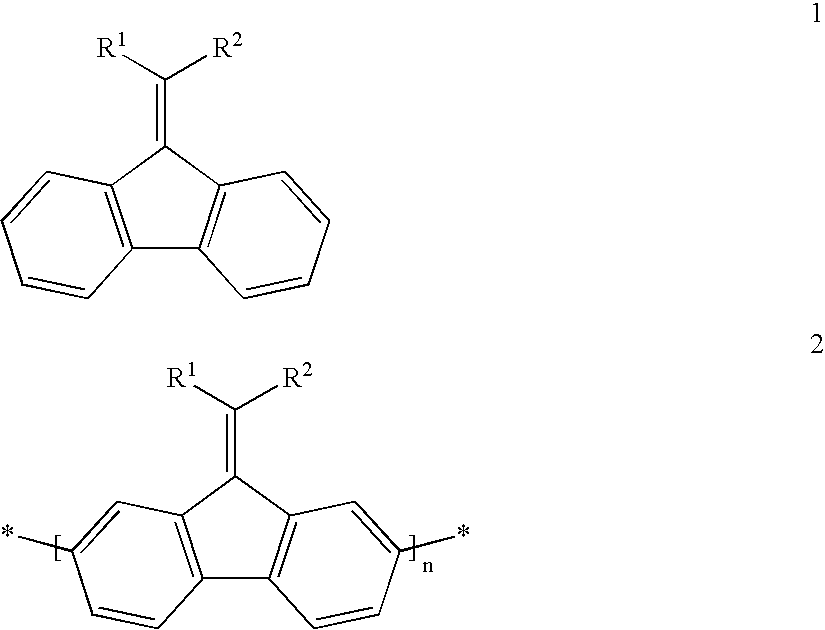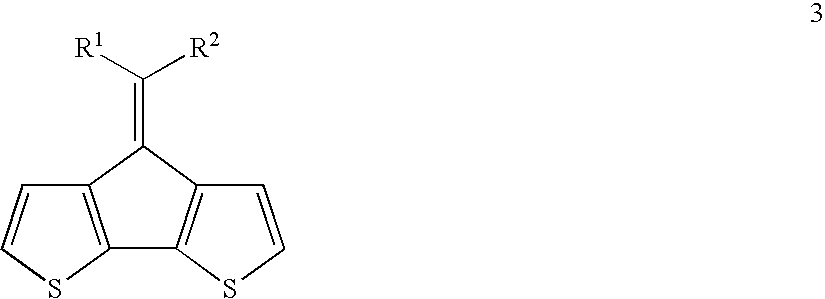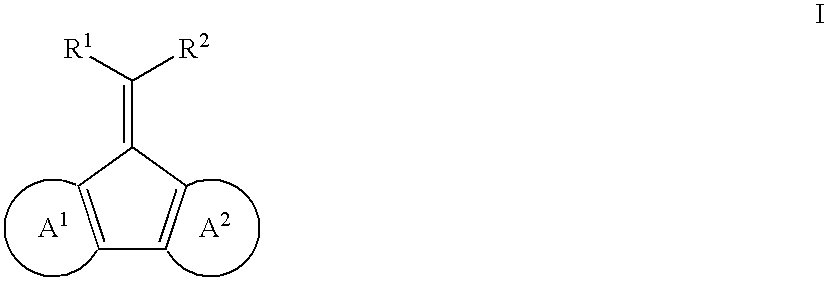Process of preparing a disubstituted 9-alkylidenefluorene or a derivative thereof
a technology of disubstituted 9alkylidene and a derivative thereof, which is applied in the preparation of halogenated hydrocarbons, organic chemistry, chemistry apparatus and processes, etc., can solve the problems of limited route, cost and lack of availability of aliphatic ketones, and the need to synthesize the starting wittig, etc., to achieve less stress development, less shrinkage, and higher retention of ordering
- Summary
- Abstract
- Description
- Claims
- Application Information
AI Technical Summary
Benefits of technology
Problems solved by technology
Method used
Image
Examples
example 2
Preparation of 2,7-dibromo-9-(bis-methylsulfanyl-methylene)fluorene (by Reaction with dimethyl trithiocarbonate):
[0104]Sodium tert-butoxide (1.24 g, 12.9 mmol) was added portionwise over 2 min to a solution of 2,7-dibromofluorene (2.0 g, 6.2 mmol) in DMSO (40 ml) at RT under nitrogen. To the resulting red solution was added dimethyl trithiocarbonate (0.94 g, 6.8 mmol) via a syringe. The reaction was stirred for 5 min and methyl iodide (1.8 g, 12.6 mmol) was added over 2 min. The reaction was stirred for 1 h worked up as above. Recrystallization from ethyl acetate / THF (2:1) afforded 2.4 g (91%). The sample was identical in all respects to that described above.
example 3
Preparation of 2,7-dibromo-9-(bis-hexylsulfanyl-methylene)fluorene:
[0105]A 60% dispersion of sodium hydride in mineral oil (0.26 g, 6.5 mmol) was added under nitrogen to 2,7-dibromofluorene (1.000 g, 3.09 mmol) in anhydrous dimethylsulfoxide (20 mL) at room temperature with stirring. The reaction mixture was stirred at room temperature for 10 minutes. Carbon disulfide (0.25 g, 0.2 mL, 3.3 mmol) was added via syringe and the reaction mixture was stirred at room temperature for 10 minutes. 1-Bromohexane (1.08 g, 6.5 mmol) was added and the reaction mixture was stirred at room temperature for 4 h. Ice-water (100 mL) was added and the resulting solid was filtered. The crude product was purified by recrystallization from iso-hexane to afford 1.225 g, (70%) as a bright yellow solid, purity 100% (GC): 1H and 13C NMR spectra as expected; M+=568 (t).
example 4
Preparation of 2,7-dibromo-9-(bisdecyl-methylene)fluorene:
[0106]To a solution of 2,7-dibromo-9-(bis-methylsulfanyl-methylene)fluorene (10.1 g, 23.5 mmol) in dry THF (150 ml) at 0° C. under nitrogen, was added a solution of lithium tetrachlorocuprate (5 ml of a 0.1M solution in THF, 2 mol %). A solution of decylmagnesium bromide (52 ml of a 1.0M solution in diethyl ether, 0.052 mol) was added dropwise over 30 min. The reaction was stirred for 2 h, during which time the internal temperature rose to 15° C. The reaction was cooled to 0° C. and further lithium tetrachlorocuprate (1 ml of a 0.1M solution in THF, 0.5 mol %) was added. The reaction was stirred a further 2 h, warming to 15° C., before quenching with 5% NaOH (100 ml). The reaction was stirred for 10 min and then filtered through celite. The organic layer was separated and the aqueous layer was further washed with ethyl acetate (100 ml). The combined organics were washed with brine (100 ml), dried (sodium sulfate), and concent...
PUM
| Property | Measurement | Unit |
|---|---|---|
| temperatures | aaaaa | aaaaa |
| temperature | aaaaa | aaaaa |
| temperature | aaaaa | aaaaa |
Abstract
Description
Claims
Application Information
 Login to View More
Login to View More - R&D
- Intellectual Property
- Life Sciences
- Materials
- Tech Scout
- Unparalleled Data Quality
- Higher Quality Content
- 60% Fewer Hallucinations
Browse by: Latest US Patents, China's latest patents, Technical Efficacy Thesaurus, Application Domain, Technology Topic, Popular Technical Reports.
© 2025 PatSnap. All rights reserved.Legal|Privacy policy|Modern Slavery Act Transparency Statement|Sitemap|About US| Contact US: help@patsnap.com



